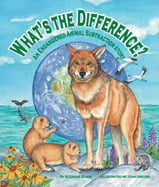Alignment to Standards for MD

| Grade | Number | Standard |
|---|---|---|
| 1 | SC-1.3.0.A.1.d | Classify organisms according to one selected feature, such as body covering, and identify other similarities shared by organisms within each group formed. |
| 1 | SC-1.3.0.E.1. | Describe some of the ways in which animals depend on plants and on each other. |
| 1 | SC-1.3.0.E.1.b | Some animals eat only plants |
| 1 | SC-1.3.0.E.1.c | Some animals eat only other animals |
| 1 | SC-1.3.0.E.1.d | Some animals eat both plants and other animals |
| 1 | SC-1.6.0.B.1. | Recognize that caring about the environment is an important human activity. |
| 1 | SC-1.6.0.B.1.b | Recognize and describe that individual and group actions, such as littering, harm the environment. |
| 1 | SC-1.6.0.B.1.c | Give reasons why people should take care of their environments. |
| 1 | SS-1.3.0.D.1.a | Describe how people in a community modify their environment to meet changing needs for shelter, such as clearing land for a housing community |
| 1 | SS-1.3.0.D.1.b | Describe why and how people protect the environment |
| 1,2 | SS-1-3.3.0.D.1. | Explain how people modify, protect and adapt to their environment |
| 2 | SC-2.2.0.A.1.d | Changes caused by humans and other animals |
| 2 | SS-2.3.0.D.1.a | Describe ways, such as clearing trees and farming land, that people modify their environment and the impact of those modifications |
| 2 | SS-2.3.0.D.1.b | Describe how and why people protect or fail to protect the environment |
| 3 | SC-3.3.0.E.1.c | sequence of changes that occur to plants and animals that die and decay. |
| 3 | SS-3.3.0.D.1.a | Describe how people in a community modify their environment to meet changing needs for transportation, shelter and making a living |
| 3 | SS-3.3.0.D.1.b | Describe why and how people make decisions about protecting the environment |
| 4 | SC-4.3.0.A.1. | Explain how animals and plants can be grouped according to observable features. |
| 4 | SC-4.3.0.A.1.a | a variety of animals or plants in both familiar and unfamiliar environments. |
| 4 | SC-4.3.0.A.1.b | Classify a variety of animals and plants according to their observable features and provide reasons for placing them into different groups. |
| 4 | SC-4.3.0.A.1.c | Given a list of additional animals or plants, decide whether or not they could be placed within the established groups or does a new group have to be added. |
| 4 | SC-4.3.0.A.1.d | Describe what classifying tells us about the relatedness among the animals or plants placed within any group. |
| 4 | SC-4.3.0.E.1. | Recognize food as the source of materials that all living things need to grow and survive. |
| 4 | SC-4.3.0.E.1.b | Describe what happens to food in plants and animals: Contributes to growth, Supports repair, Provides energy, Is stored for future use, Is eliminated |
| 4 | SC-4.3.0.F.1.a | Explain ways that individuals and groups of organisms interact with each other and their environment. |
| 4 | SC-4.3.0.F.1c | Identify and describe the interactions of organisms present in a habitat: Beneficial interactions: nesting, pollination, seed dispersal, oysters filtering as in the Chesapeake Bay, etc. |
| 4 | SC-4.3.0.F.1d | Identify and describe the interactions of organisms present in a habitat: Roles within food chains and webs: scavengers, decomposers, producers, consumers. |
| 4 | SC-4.3.0.F.1e | Explain that changes in an organisms habitat are sometimes beneficial to it and sometimes harmful. |
| 5 | SC-5.3.0.E.1. | Recognize that some source of energy is needed for all organisms to grow and survive. |
| 5 | SC-5.3.0.E.1.c | Plants and animals use food for energy and growth |
| 5 | SC-5.3.0.E.1.d | some insects and various other organisms depend on dead plant and animal material for food. |
| 5 | SC-5.3.0.E.1.e | most animals food can be traced back to plants.\ |
| 5 | SC-5.6.0.B.1.b | Identify and describe that individuals and groups assess and manage risk to the environment differently. |
| 5 | SC-5.6.0.B.2.b | human activities may have a negative consequence on the natural environment: Damage or destruction done to habitats, Air, water, and land pollution |
| K | SC-K.3.0.A.1.b | features that make some animals and some plants very different from one another. |
| K | SC-K.3.0.D.1.b | describe and compare living things found in other states such as Texas and Alaska to those found in Maryland. |
| K | SC-K.3.0.E.1.b | Describe ways that people and other animals manage to bring the things they need from their environment into their bodies. |
| K | SC-K.3.0.F.1.c | Describe ways that animals and plants found in each place interact with each other and with their environment. |
| K | SS-K-3.0.D.1. | Describe how people adapt to and modify their immediate environment |
| K | SS-K-3.0.D.1.b | ways people change environment to meet their needs: planting crops, cutting forests |
| PK | SC-PK.3.0.A.1.a | how some animals are alike in the way they look and in the things they do. |
| PK | SS-PK-3.0.D.1. | Describe how people adapt to their immediate environment |
| PK-2 | SC-PK-2.1.0.A.1.g | Use whole numbers and simple, everyday fractions in ordering, counting, identifying, measuring, and describing things and experiences. |